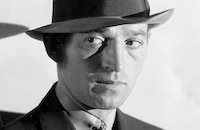The Phantom of Crestwood

Brief Synopsis
Cast & Crew
J. Walter Ruben
Ricardo Cortez
Karen Morley
Anita Louise
Pauline Frederick
H. B. Warner
Film Details
Technical Specs

Synopsis
In Los Angeles, attractive gold digger Jenny Wren pays a visit to a former lover, married bank president Priam Andes, and insists that he invite three of his wealthy friends--William Jones, Senator Herbert Walcott and Eddie Mack--to a weekend party at "Crestwood," his seaside estate. During the party, Jenny teases the three men, all former lovers, in front of their respective wives and fiancées. Then, in the Crestwood library, she announces her "retirement" to Priam and his friends and demands hundreds of thousands of dollars in "hush" money from them. When asked why she is retiring, Jenny relates the story of Tom Herrick, a college student who threw himself off a cliff in the Adirondacks after she had coldly rejected him because he had no money. That night, during a raging storm, Jenny sees a terrifying vision of Tom in the woods outside her bedroom window. Soon after, Gary Curtis, a New Yorker who has been following Jenny and has slipped into the house along with Pete Harris and his gang of robbers, finds her dead body in the darkened living room. Sure that the police will arrest him for the murder because he has a criminal record, Gary, who came to Crestwood to retrieve love letters sent to Jenny by his boss in New York, declares his intention of discovering the killer himself. After finding Esther Wren, Jenny's younger sister who is engaged to Priam's nephew Frank, unconscious in Jenny's room, Gary questions her and the other guests, including Frank and his aunt Faith, about their dealings with Jenny. Eventually Gary determines that Jenny was killed with a dart and that one of the guests, Mr. Vayne, is actually Henry T. Herrick, Tom's father. Herrick then confesses that, for revenge, he had used a death mask of his son's face to scare Jenny. After denying that he killed Jenny, Herrick dies of a heart attack. The lights then go out and Esther is stabbed just as she declares that she remembers an important clue about the murder. With the evidence apparently pointing to Jenny's maid, Carter, Gary and Pete search for the servant in the secret passages of the old house. When they find Carter dead, however, they conclude that Faith, who, for reasons of family pride, had strongly disapproved of Frank's engagement to Esther, had mistaken Jenny for Esther and had accidentally killed her. Fearful that Carter knew too much, Faith killed her as well. As a half-mad Faith is about to push the wounded Esther off a cliff, Gary and Pete arrive and stop her. As the police helicoptors circle overhead, Faith throws herself off the cliff.

Director
J. Walter Ruben
Cast

Ricardo Cortez

Karen Morley

Anita Louise

Pauline Frederick

H. B. Warner

Mary Duncan

Sam Hardy
Tom Douglas
Richard "skeets" Gallagher

Ivan Simpson
Aileen Pringle

George E. Stone

Robert Mcwade
Hilda Vaughn

Gavin Gordon
Matty Kemp
Clarence Wilson
Eddie Sturgis
Robert Elliot
Crew
Carroll Clark
Merian C. Cooper
Bartlett Cormack
Bartlett Cormack
D. A. Cutler
Henry Gerrard
James Hartnett
Archie F. Marshek
J. Walter Ruben
David O. Selznick
Max Steiner

Film Details
Technical Specs

Articles
The Phantom of Crestwood -
By Richard Harland Smith

The Phantom of Crestwood -
Quotes
Trivia
The film was originally presented as a radio serial with the final episode left out! If the listener wanted to know the ending, they had to watch the film.
Notes
According to RKO inter-office memoranda and Variety, RKO broadcast a radio version of this story called The Phantom, which was part of a promotional contest. The radio show, which was broadcast on NBC's "Hollywood-on-the-Air" program, began in August 1932 and concluded six weeks later on a "cliff-hanger" note. The contest consisted of listeners submitting their own endings to the story. The first winners of the contest were to be announced on the NBC program on November 24, 1932, according to inter-office memoranda. The Variety reviewer noted that the film included a "brief prolog in a broadcasting studio with Graham McNamee identifying the production with the air contest." Graham McNamee was a well-known radio personality. This "prolog" was not seen in the viewed print, however. Variety also commented on the film's use of flashbacks, which the reviewer described as the "heaviest use of this once standard device since the talking picture came to the fore." RKO borrowed Karen Morely from M-G-M for the production. Modern sources state that the film made RKO $100,000 at the box office, profits that suggest that the radio contest was a successful promotional gimmick.















